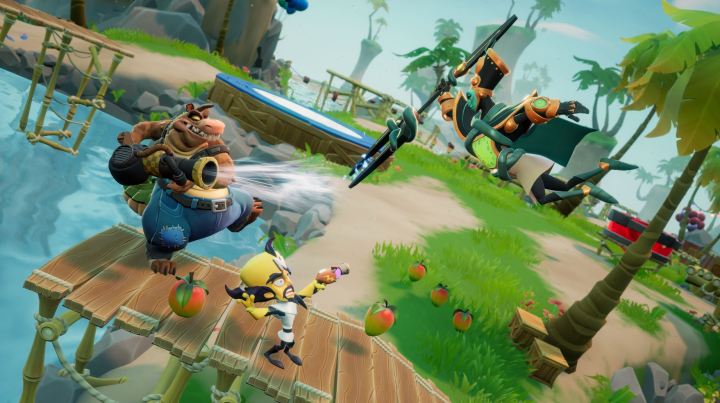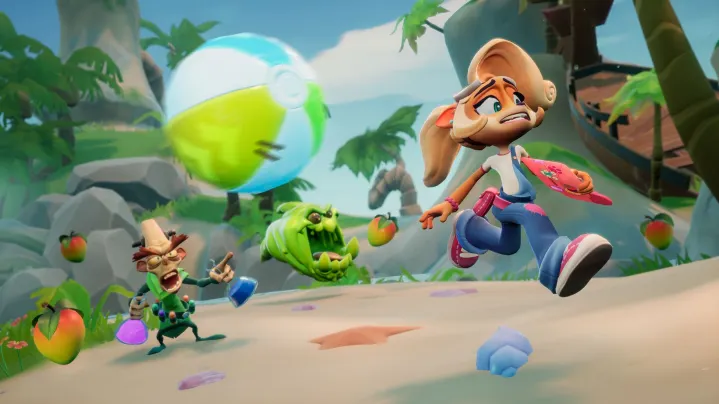Crash Team Rumble is a shining example of a game that you really need to play to understand. When it was first revealed at The Game Awards 2022, I was left entirely baffled by the Crash Bandicoot spinoff. A breakneck trailer teased a 4v4 action game that had classic Crash characters spinning into one another, breaking boxes, and platforming around a small map. I had no idea what it was and fans watching at home didn’t seem to either. But any disappointment I felt at the time entirely evaporated the moment I got hands-on with it at this year’s Game Developers Conference.
After struggling to describe it themselves, the team behind the game sat me down with a tutorial that made everything crystal clear. And after just one full multiplayer match, I was entirely smitten. If you’ve already written off Crash Team Rumble as a lame spinoff, you’re going to want to give it a second chance, lest you miss out on an incredibly creative multiplayer invention that’s an absolute blast.
What the Wumpa?
I’m tempted to call Crash Team Rumble a “genre mash-up,” drawing comparisons to sports games and MOBAs, but that description undersells it. Developer Toys for Bob has invented what feels like an entirely new genre altogether here. Here’s the basic gist: It’s a 4v4 competitive game where teams run around a small map, collect as much Wumpa fruit as they can, and bank it in their goal by standing on it for a few seconds to raise their team’s score. Its closest parallel is perhaps Destiny 2’s Gambit mode, where Guardians fight to bank motes, but even that doesn’t really explain it.
There are several layers on top of that, all of which add depth without making matches feel too complicated to grasp. For one, it has a character class system like Overwatch that fits surprisingly well. Characters like Crash Bandicoot are “scorers” who specialize in racking up points. Blockers, on the other hand, can be used to get in the other team’s way. In one game, I played as Dingodile, who has the ability to vacuum fruits away from other players. His high health meant that I could sit on the other team’s bank and block anyone from depositing their fruits – a true jerk.

Boosters are a little different, as they tie into the game’s relic system. Relics are scattered around the maps and can be used to unlock different abilities. When I collect five on a beach map, I can stand on a round platform to cash them in and turn them into a beach ball that speeds over the sand. Other maps let me spend them to launch myself up to high places or place force fields around my bank. Support heroes like Coco will find double relics throughout the islands, so their focus is more on activating those abilities. All characters can also equip a special ability, like a healing locker or a plant that slows enemies by spitting venom at them, adding even more to the team-building aspect.
Toys for Bob representatives tell me that the class system wasn’t in the game originally. It only came about because the developers kept unofficially breaking their teams into those roles during playtests. They eventually decided that the metagame should just be in the game itself, and that was the right call. When my team spent some prep time picking our characters carefully and calling out what we were doing, it truly felt like we were prepping for a serious esport.
When demoing multiplayer games like this, it can sometimes be hard to get an unclouded feel for how fun a match is. Admittedly, my experience was positively colored by a room full of enthusiastic players who hooted, hollered, and smack-talked one another. But even without that, Crash Team Rumble really accomplishes something special here. Its fruit-collecting goal is clear and is easy for a new player to pick up, but the extra nuance gives it much more depth.
For instance, if a team activates a series of gem platforms by jumping on them, they’ll give their team a bonus multiplier that increases the value of fruits. That adds another layer of risk/reward strategy, as a crafty team might stock up on fruits, but wait to unload them all at the height of a multiplier.

All of these little ideas really came together for me during one specific moment. In a particularly tense match, both teams were tied up near the end. When a win was within range, my teammates started rushing back toward our base to bank all our fruits at once. Naturally, a blocker from the enemy team gave chase. As they approached the bank, a teammate made an absolutely clutch play by spending their saved relics to generate a force field in front of the bank. It shot up just a split second before the blocker could reach it, allowing everyone to bank their fruits and run away with a lead. It was an exhilarating moment that even had the developers on hand scrambling to figure out how to save gameplay clips on a PlayStaion 5.
Will moments like that be as thrilling when you’re playing solo online with strangers? It’s always hard to say, but that alone sold me on the idea of Crash Team Rumble as a legitimate multiplayer contender. If it can nail down a steady stream of post-launch support that keeps it fresh from month to month, I get the sense that it’ll turn those initial skeptics into fans. It may not be Crash Bandicoot 5, but it might just be the smartest use of the IP since its early PlayStation days.
Crash Team Rumble launches on June 20 for PS4, PS5, Xbox One, and Xbox Series X/S. It’ll have a beta from April 20 to 24.
Editors’ Recommendations
Services Marketplace – Listings, Bookings & Reviews